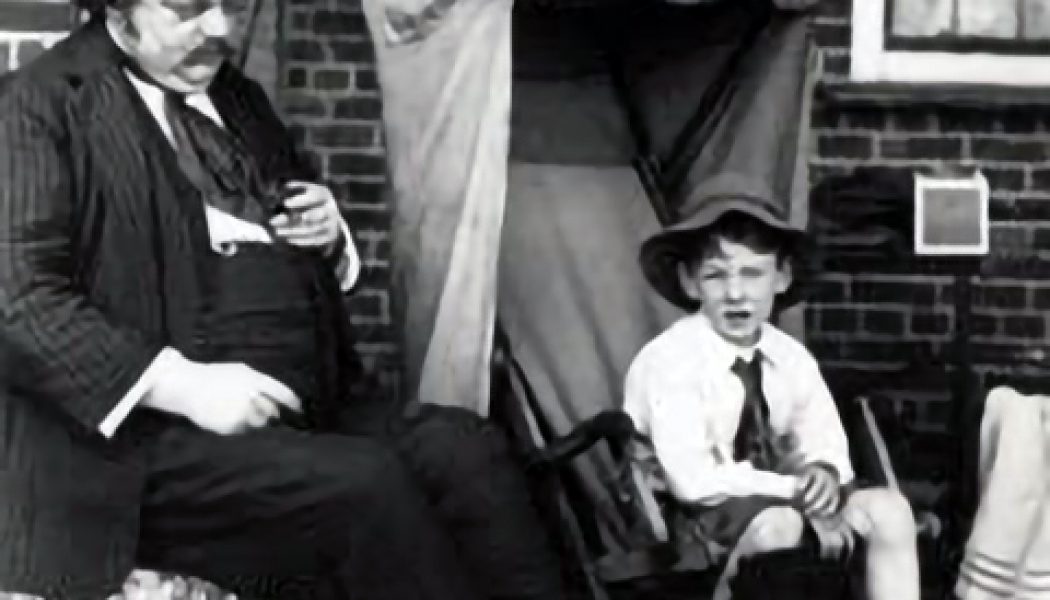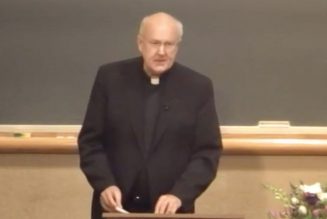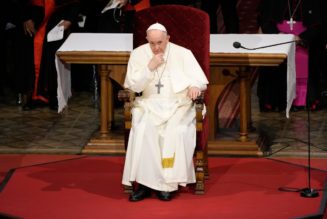ABOVE: G.K. Chesteron’s home Overroads in Beaconsfield, England (Photo by Ken Sladen). BELOW: G.K. Chesterton sits with an unidentified boy at Overroads (National Portrait Gallery Photo Collection).
G.K. Chesterton’s Historic Home in England Faces Demolition
Admirers of G.K. Chesterton worldwide have launched a campaign to stop developers from knocking down Overroads and putting up an apartment block.
K.V. Turley
LONDON — Devotees of G.K. Chesterton are up in arms over plans to demolish the acclaimed Catholic writer and philosopher’s former home, Overroads.
Developers want to knock down the house and replace it with an apartment block.
Dale Ahlquist, the president of the Society of Gilbert Keith Chesterton and of The Chesterton Schools Network, has described the proposed action as “awful.” He said, “I had feared this might happen, as the owners of Overroads had contacted me in their attempts to sell the property.”
Ahlquist added, “I will do whatever I can to help make the appeal to prevent this historic residence from being destroyed.” He urged all Chestertonians to do likewise.
Leading the local fight to preserve Overroads, approximately 45 minutes northwest of London, is Ken Sladen, for the last 25 years owner-occupier of Top Meadow, Chesterton’s final home, which is situated next door to Overroads.
Speaking to the Register Thursday, Sladen bemoaned the proposed demolition of Overroads.
“Overroads is intrinsically linked with the current Grade II listed building, Top Meadow,” he said. “The application made by the developers is in close proximity to that listed building … and so they are required to prove it does not harm the setting of that building. Demolishing one half of the pair would have a significant negative contribution on the setting of a listed building, which should be avoided at all costs. Additionally, we would lose forever through demolition a true heritage asset of one of our greatest literary giants.”
“We believe they [the developers] have deliberately played down the part Overroads played in Chesterton’s passion for selecting Beaconsfield as a place to live and work for the remainder of his life,” said Sladen. “In fact, Overroads, in its own right, has such a historical connection with Chesterton it merits retention in its own right as part of Beaconsfield’s heritage.”
In 1909, Chesterton and his wife Frances left London to live in Beaconsfield, Buckinghamshire, where the Chestertons were to live for the rest of their lives, living first at Overroads (from 1909-1922) and then at Top Meadow.
Chesterton was so impressed with the Arts and Crafts design and the setting of Overroads that in 1911 he commissioned the architect, P. Morley Horder, to design “a typically English home of oak beams and wrought iron fittings following the pattern of Overroads.” The reason for the building was one of space. Initially, it was envisaged that the new property would be used only as Chesterton’s studio, where he could work.
During the next 10 years, when what would become known as Top Meadow was being constructed, the couple continued to live happily at Overroads. It was a period of immense creativity and output for Chesterton. The Ballad of the White Horse, Manalive, Magic, and The Flying Inn — to say nothing of the countless essays and journalism — were all written at the house.
 In total, the Chestertons lived at Overroads for 13 years, almost the same length of time as they were to live at Top Meadow. That latter building was, in due course, expanded into a house and the Chestertons moved there permanently in 1922. The site of Top Meadow Cottage lay within its grounds. This cottage became the residence for the couple’s long-time secretary and surrogate daughter, Dorothy Collins. Gilbert and Frances lived at Top Meadow until their respective deaths in 1936 and 1938.
In total, the Chestertons lived at Overroads for 13 years, almost the same length of time as they were to live at Top Meadow. That latter building was, in due course, expanded into a house and the Chestertons moved there permanently in 1922. The site of Top Meadow Cottage lay within its grounds. This cottage became the residence for the couple’s long-time secretary and surrogate daughter, Dorothy Collins. Gilbert and Frances lived at Top Meadow until their respective deaths in 1936 and 1938.
In their will, the Chestertons left both houses, Overroads and Top Meadow, to the local Catholic diocese. They requested that the property be used as a seminary, a convent, or as a temporary resting place for Anglican clergymen who had converted to Catholicism. For a number of years, this was indeed how Top Meadow was used. Eventually, however, the diocese sold both properties. Today, both houses are privately owned. Although Top Meadow is recognized as a building with historical significance and so classified as a “listed building” — and thus enjoys some measure of protection — Overroads has no such status.
The current owner of Overroads put the house on the market, with an asking price of 1.9 million pounds (about $2.4 million dollars). But, having secured no buyer, the owners are now considering selling the property to a developer, Octagon Developments. The developer plans to demolish the existing structure and build a new apartment block on the site. With nothing other than market forces at play, there appears little to prevent the bulldozing of Overroads.
With documents lodged with Chiltern and South Bucks Councils requesting demolition, the indications are that, as early as mid-January, the authorities may make a decision, and that rebuilding post-demolition of Overroads is expected to be completed early 2023.
Sladen has met with members of the local council, South Bucks Council. They “agreed to object to the original planning application,” he explained, “which included a call to demolish Overroads. But, unfortunately, they do not have the final say and can only register support or objection to an application, with the final decision resting with the South Bucks Council planning meeting. And so far this item has not been discussed by them.”
Sladen said he has contacted the local principal conservation and listed buildings officer whom, he says, “is very supportive of this building being protected and supports any measure which can do so.” He has also made an application to English Heritage, the body that controls the listing of all protected buildings in the United Kingdom but, as yet, no decision on Overroads has been communicated.
Rachel Prance, the communications, performance and policy manager for the planning committee, told the Register Jan. 10, “The application for demolition has not yet been determined so we aren’t able to comment at this stage.”
“This application is to determine whether the prior approval of the District Planning Authority is required for the method of demolition of the existing buildings/structures on the site,” she said via email.
News of what is proposed in Beaconsfield has reverberated around the world. Marco Sermarini, the president of the Italian Chesterton Society, has written to the Beaconsfield planning authorities. He stated in his submission that the destruction of this “beautiful house would be a great loss” and that it would be better to preserve “this noble house so meaningful for European culture, a symbol of hope for people all over the world.” He added that he spoke on behalf of hundreds of members of the Italian Chesterton Society, and, no doubt, many more thousands of Chestertonians across the globe.
Sermarini told the Register Jan. 9, “I have visited Beaconsfield three times and I love that town because it is home of the great Gilbert Keith Chesterton. … During one of my visits I had the chance to see inside Overroads” where he glimpsed “a metal plate nailed to the inside of the beam in front of the entrance door” telling of the illustrious former owner.
Sladen described the proposed demolition of Overroads as causing “a tragic loss to the town of Beaconsfield and also to the many hundreds of Chesterton followers from around the world who visit Beaconsfield to pay homage to one of England’s greatest literary giants.”
He added, “Overroads was not just instrumental in the design and setting of Top Meadow but also in the life and work of Chesterton.”
Canon John Udris, a priest of the Diocese of Northampton, carried out the preliminary investigation into Chesterton’s cause for canonization. He told the Register, “I’ve just been reading G.K.’s Ballad of the White Horse. It would have been in Overroads that he wrote that magnificent poem, which is all about fighting for something even when it seems hopeless. It’s great to witness such a groundswell of people, both local and abroad, fighting this latest move of the so-called ‘developers.’ I’m sure G.K. would have had something choice to say about their concept of development. But for us the fight is important. In that ballad King Alfred relishes a battle against all the odds, as Chesterton himself always did. Whether or not we win, the fight is worth it.”
Should anyone wish to submit objections, they have to be registered by Jan. 16, 2020, quoting the reference numbers PL/19/4410/DM and PL/19/3379/FA. The addresses to which they should be sent are planning@chilternandsouthbucks.gov.uk and planning.comments@chilternandsouthbucks.gov.uk.
K.V. Turley is the Register’s U.K. correspondent









